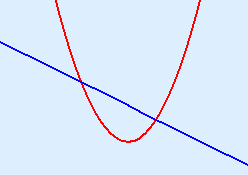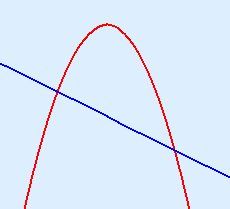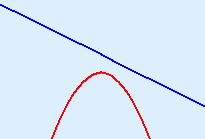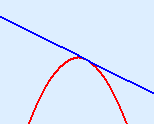Inequalities » Quadratic inequalities
When solving a quadratic inequality, you solve the corresponding equation first, to calculate the point(s) of intersection. Just like with linear inequalities.
Then you decide on the solution using a sketch or the number line.
You have to know the meaning of the different signs being used.
If necessary, check domain and range for theory about intervals.
Example 1
a2 + 30 < –11a + 2
a2 + 30 = –11a + 2
a2 + 11a + 28 = 0
(a + 4)(a + 7) = 0
a = –4 or a = –7
| Continue with sketch | Continue with number line | ||||||||||||
|
There are two points of intersection and the graph is a upward-opening parabola. That gives you this sketch:  Look to the original inequality: a2 + 30 < –11a + 2 Parabola < line That is in between the points of intersection. Solution: –7 < a < –4 |
Calculate whether or not the inequality is correct for numbers outside and in between the solutions. Outside the points of intersection: Take for example a = –8.
In between the two solutions: Take for example a = –6.
You may sketch a number line to help you.  Because 'in between' is correct, the solution is: –7 < a < –4 |
Example 2
| –2x2 – 4x – 69 | ≤ –28x – 5 |
| –2x2 – 4x – 69 | = –28x – 5 |
| –2x2 + 24x – 64 | = 0 |
| x2 – 12x + 32 | = 0 |
| (x – 4)(x – 8) | = 0 |
| x = 4 of x = | 8 |
| Continue with sketch | Continue with number line | ||||||||||||||||
|
There are two points of intersection and the graph is a downward-opening parabola. That gives you this sketch:  Look to the original inequality:
Solution: x ≤ 4 or x ≥ 8 |
Calculate whether or not the inequality is correct for numbers outside and in between the solutions. Outside the points of intersection: Take for example x = 2.
In between the two solutions: Take for example x = 5.
You may sketch a number line to help you.  Because 'outside' is correct, the solution is: x ≤ 4 or x ≥ 8 |
Watch out with:
No intersections (see sketch)Parabola < line or parabola ≤ line Solution: for every value of x Parabola > line or parabola ≥ line Solution: for no value of x |
 |
One point of intersection/tangent* (see sketch)*A tangent in this context is the point where the graphs touch. Parabola < line Solution: x ≠ 1 (Every value of x except x = 1) Parabola > line Solution: for no value of x Parabola ≤ line Solution: for every value of x Parabola ≥ line Solution: x = 1 |
 tangent at x = 1 |